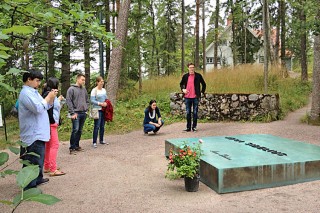Title

Members of Juilliard’s Axiom ensemble pay homage at the grave of Jean Sibelius. From left, violinist Ken Hamao, violist Jocelin Pan, flutist Nicholas Johnson, bassoonist Allison Nicotera, oboist Lauren Williams, and clarinetist Anton Rist.
(Photo by Ara Guzelimian)A group of intrepid Juilliard Axiom musicians landed at Helsinki’s Vantaa Airport late in August, eagerly anticipating the culmination of a collaboration with musicians from the celebrated Sibelius Academy in the Finnish capital. This was the second half of a project that included performances of music by younger Finnish and American composers both in New York at Alice Tully Hall and in Helsinki at the city’s beautiful new concert hall.
Body
On the morning after their transcontinental flight, I joined a hardy band of seven Axiom members and the ensemble’s manager, Rosemary Metcalf, for a moving musical pilgrimage to Ainola, the home of Jean Sibelius, the composer who still very much defines Finland’s musical identity. We set out from Helsinki’s landmark train station (designed by Eliel Saarinen) on a commuter railroad for the half-hour journey to Jarvenpaa, a small town about 25 miles north of the city.
We got off the train seemingly in the middle of nowhere, then walked through fields and woods for about a mile to the house. Sibelius and his family moved there in 1904; he was to live there until his death in 1957. It was lovingly preserved first by his widow Aino, then by his daughters until it was transferred to the nation as a historic site. The home is exactly as it was when Sibelius lived there—we had an overpowering sense of his presence. Looking into his bedroom, we could see his hat and walking stick on a chair, his clothes hanging in a wardrobe.
So much extraordinary music was written under that roof, beginning with the revised version of the Violin Concerto and the Third Symphony. Sibelius’s composing study was perhaps most meaningful to us—he worked at a desk looking out at the forest and lake, with a bust of Beethoven peering down on him from a nearby shelf. We could easily imagine how the setting helped shape the extraordinary music.
After the visit to the house, we walked into the garden to an opening in the trees, where both Jean and Aino Sibelius are buried in a simple grave. Our entire group became instinctively silent and contemplative, just paying homage to a great creative spirit.
At the end of our time at Ainola, there was a lovely bonus—a basket of apples harvested from the composer’s apple trees waiting by the exit. We all took apples, eating them on our walk back to the train, the literal fruits of a great composer’s garden.




